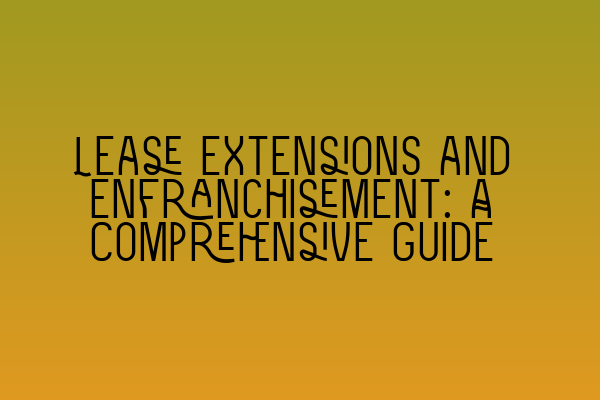Lease Extensions and Enfranchisement: A Comprehensive Guide
As the leading experts in property law, at SQE Property Law & Land Law, we understand the complexities and intricacies of lease extensions and enfranchisement. Whether you are a landlord or a tenant, it is crucial to have a thorough understanding of these concepts to ensure your rights are protected and your interests are well served.
What is a Lease Extension?
A lease extension refers to the process of extending the term of a lease agreement beyond its original expiration date. This is typically done to provide security and stability to the tenant and maintain the value of the property.
There are several reasons why a lease extension may be necessary:
- The tenant wants to continue occupying the property for an extended period.
- The tenant wants to enhance the value of the property by extending the lease.
- The tenant wants to sell the property, and a longer lease would make it more attractive to potential buyers.
Now, let’s dive deeper into the process of lease extensions.
The Process of Lease Extensions
1. Determine eligibility: Before initiating a lease extension, it is important to determine if you are eligible. In general, tenants with a lease of more than two years are eligible to apply for a lease extension.
2. Negotiate terms: Once eligibility is established, the next step is to negotiate the terms of the lease extension with the landlord. This includes determining the new lease length, the ground rent, and any additional terms and conditions.
3. Serve a Section 42 Notice: To formally initiate the lease extension process, tenants must serve a Section 42 Notice under the Leasehold Reform, Housing, and Urban Development Act 1993. This notice should outline the proposed terms of the lease extension.
4. Landlord’s response: Upon receiving the Section 42 Notice, the landlord has two months to respond. They can either accept the proposed terms or negotiate alternative terms.
5. Agree on terms: If both parties agree on the terms, a new lease is granted, and the lease extension is completed. If no agreement is reached, the matter may need to be referred to a tribunal for resolution.
What is Enfranchisement?
Enfranchisement is the process by which a leaseholder has the right to purchase the freehold of their property. This offers numerous benefits, including increased control over the property, elimination of ground rent, and potential financial gains.
There are two main types of enfranchisement:
- Leasehold Enfranchisement: This is a collective process where tenants in a building or complex join forces to collectively purchase the freehold from the landlord.
- Individual Enfranchisement: This process allows an individual leaseholder to purchase the freehold of their property directly from the landlord.
Let’s delve into the process of enfranchisement.
The Process of Enfranchisement
1. Confirm eligibility: Before proceeding with enfranchisement, it is crucial to confirm your eligibility. This includes meeting certain criteria such as the length of the lease and the number of qualifying tenants.
2. Form a tenants’ association (for collective enfranchisement): In the case of collective enfranchisement, tenants must form a tenants’ association to represent their interests and facilitate the purchase of the freehold collectively.
3. Serve a Section 13 Notice (for individual enfranchisement): For individual enfranchisement, the leaseholder must serve a Section 13 Notice on the landlord, expressing their desire to purchase the freehold of the property.
4. Valuation: Once the landlord receives the Section 13 Notice (or in the case of collective enfranchisement, the tenants’ association serves the Initial Notice), a valuation process takes place to determine the price of the freehold.
5. Negotiate terms: Following the valuation, the leaseholder (or tenants’ association) and the landlord negotiate the terms of the purchase, including the purchase price and any additional terms and conditions.
6. Completion: If both parties agree on the terms, the purchase is completed, and the leaseholder becomes the freehold owner of the property.
The Importance of Legal Advice
Lease extensions and enfranchisement are complex legal processes that require careful consideration and expert guidance. Engaging the services of a qualified property law solicitor is essential to ensure your rights are protected and your interests are well-represented throughout the process.
The team at SQE Property Law & Land Law is well-versed in lease extensions and enfranchisement, and we have successfully assisted numerous clients in navigating these complex areas of property law.
Whether you are a tenant seeking a lease extension or a leaseholder exploring enfranchisement options, our experienced solicitors are here to provide you with the necessary legal advice and support. Contact us today to schedule a consultation and discuss your specific requirements.
Related Articles:
SQE Preparation for Property Practice: Mapping Out Your Strategy,
Updates in UK Property Laws: Key Changes and Implications,
Legal challenges in property transactions: A comprehensive guide,
Navigating Lease Laws in the UK: Essential Guidelines for Tenants and Landlords,
Dominate Property Law Questions: Avoiding Common Pitfalls
